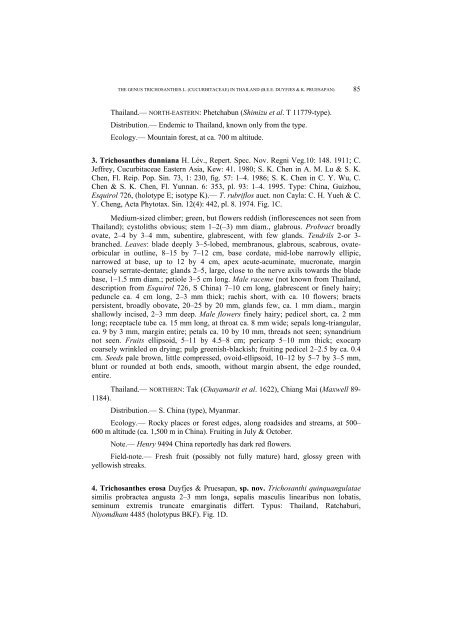The genus Trichosanthes L. (Cucurbitaceae) in Thailand ...
The genus Trichosanthes L. (Cucurbitaceae) in Thailand ...
The genus Trichosanthes L. (Cucurbitaceae) in Thailand ...
Create successful ePaper yourself
Turn your PDF publications into a flip-book with our unique Google optimized e-Paper software.
THE GENUS TRICHOSANTHES L. (CUCURBITACEAE) IN THAILAND (B.E.E. DUYFJES & K. PRUESAPAN) 85<br />
<strong>Thailand</strong>.— NORTH-EASTERN: Phetchabun (Shimizu et al. T 11779-type).<br />
Distribution.— Endemic to <strong>Thailand</strong>, known only from the type.<br />
Ecology.— Mounta<strong>in</strong> forest, at ca. 700 m altitude.<br />
3. <strong>Trichosanthes</strong> dunniana H. Lév., Repert. Spec. Nov. Regni Veg.10: 148. 1911; C.<br />
Jeffrey, <strong>Cucurbitaceae</strong> Eastern Asia, Kew: 41. 1980; S. K. Chen <strong>in</strong> A. M. Lu & S. K.<br />
Chen, Fl. Reip. Pop. S<strong>in</strong>. 73, 1: 230, fig. 57: 1–4. 1986; S. K. Chen <strong>in</strong> C. Y. Wu, C.<br />
Chen & S. K. Chen, Fl. Yunnan. 6: 353, pl. 93: 1–4. 1995. Type: Ch<strong>in</strong>a, Guizhou,<br />
Esquirol 726, (holotype E; isotype K).— T. rubriflos auct. non Cayla: C. H. Yueh & C.<br />
Y. Cheng, Acta Phytotax. S<strong>in</strong>. 12(4): 442, pl. 8. 1974. Fig. 1C.<br />
Medium-sized climber; green, but flowers reddish (<strong>in</strong>florescences not seen from<br />
<strong>Thailand</strong>); cystoliths obvious; stem 1–2(–3) mm diam., glabrous. Probract broadly<br />
ovate, 2–4 by 3–4 mm, subentire, glabrescent, with few glands. Tendrils 2-or 3branched.<br />
Leaves: blade deeply 3–5-lobed, membranous, glabrous, scabrous, ovateorbicular<br />
<strong>in</strong> outl<strong>in</strong>e, 8–15 by 7–12 cm, base cordate, mid-lobe narrowly ellipic,<br />
narrowed at base, up to 12 by 4 cm, apex acute-acum<strong>in</strong>ate, mucronate, marg<strong>in</strong><br />
coarsely serrate-dentate; glands 2–5, large, close to the nerve axils towards the blade<br />
base, 1–1.5 mm diam.; petiole 3–5 cm long. Male raceme (not known from <strong>Thailand</strong>,<br />
description from Esquirol 726, S Ch<strong>in</strong>a) 7–10 cm long, glabrescent or f<strong>in</strong>ely hairy;<br />
peduncle ca. 4 cm long, 2–3 mm thick; rachis short, with ca. 10 flowers; bracts<br />
persistent, broadly obovate, 20–25 by 20 mm, glands few, ca. 1 mm diam., marg<strong>in</strong><br />
shallowly <strong>in</strong>cised, 2–3 mm deep. Male flowers f<strong>in</strong>ely hairy; pedicel short, ca. 2 mm<br />
long; receptacle tube ca. 15 mm long, at throat ca. 8 mm wide; sepals long-triangular,<br />
ca. 9 by 3 mm, marg<strong>in</strong> entire; petals ca. 10 by 10 mm, threads not seen; synandrium<br />
not seen. Fruits ellipsoid, 5–11 by 4.5–8 cm; pericarp 5–10 mm thick; exocarp<br />
coarsely wr<strong>in</strong>kled on dry<strong>in</strong>g; pulp greenish-blackish; fruit<strong>in</strong>g pedicel 2–2.5 by ca. 0.4<br />
cm. Seeds pale brown, little compressed, ovoid-ellipsoid, 10–12 by 5–7 by 3–5 mm,<br />
blunt or rounded at both ends, smooth, without marg<strong>in</strong> absent, the edge rounded,<br />
entire.<br />
<strong>Thailand</strong>.— NORTHERN: Tak (Chayamarit et al. 1622), Chiang Mai (Maxwell 89-<br />
1184).<br />
Distribution.— S. Ch<strong>in</strong>a (type), Myanmar.<br />
Ecology.— Rocky places or forest edges, along roadsides and streams, at 500–<br />
600 m altitude (ca. 1,500 m <strong>in</strong> Ch<strong>in</strong>a). Fruit<strong>in</strong>g <strong>in</strong> July & October.<br />
Note.— Henry 9494 Ch<strong>in</strong>a reportedly has dark red flowers.<br />
Field-note.— Fresh fruit (possibly not fully mature) hard, glossy green with<br />
yellowish streaks.<br />
4. <strong>Trichosanthes</strong> erosa Duyfjes & Pruesapan, sp. nov. Trichosanthi qu<strong>in</strong>quangulatae<br />
similis probractea angusta 2–3 mm longa, sepalis masculis l<strong>in</strong>earibus non lobatis,<br />
sem<strong>in</strong>um extremis truncate emarg<strong>in</strong>atis differt. Typus: <strong>Thailand</strong>, Ratchaburi,<br />
Niyomdham 4485 (holotypus BKF). Fig. 1D.
















